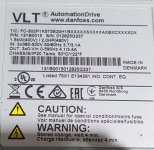Hi all, having a brain fade moment. I need your help.
I have a inverter duty SEW 6 terminal 230V delta / 400V star motor here wired to a Danfoss drive that is supplied with 415V 3 phase.
I left the motor as found connected in delta and I changed the VSD motor volts parameter of the VSD to 230V.
Is this right? Or should I have wired the motor in star and left the VSD motor volts parameter at 400V?
I have a inverter duty SEW 6 terminal 230V delta / 400V star motor here wired to a Danfoss drive that is supplied with 415V 3 phase.
I left the motor as found connected in delta and I changed the VSD motor volts parameter of the VSD to 230V.
Is this right? Or should I have wired the motor in star and left the VSD motor volts parameter at 400V?





